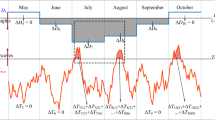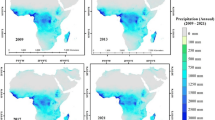Abstract
Nowadays, extreme temperatures are associated with global warming and cause great concerns worldwide, particularly in Africa because of low resilience, adaptation and mitigation strategies. The present study investigates the performance of RegCM4 climate model in reproducing extreme temperatures over Central Africa (CA) during 2002–2006 period. Apart of daily minimum and maximum temperatures, the study uses six extreme temperature indices based on the recommendations of Expert Team on Climate Change Detection and Indices. These include four intensity indices and two duration indices. Focus has been done in two sub-regions embedded over the study area for more specific analysis. The first sub-region named zone 1 is semi-arid while the second one named zone 2 is humid. We found that whatever the region or season over CA, RegCM4 displays fairly well the intensity indices associated to daily minimum temperatures, namely \(TN_{N}\) and \(TN_{X}\), with underestimations not exceeding \(4\,^{\circ }\)C. For intensity indices based on daily maximum temperatures, namely \(TX_{X}\) and \(TX_{N}\), the warm bias can reach up to \(10\,^{\circ }\)C. This model behavior is associated to its inability to depict surface downward solar and thermal fluxes as well as surface sensible heat flux. Regarding the duration indices, RegCM depicts the hot sequences with high biases, unlike the cold sequences. Statistical parameters used for evaluation show that despite the differences between model and ERA5, RegCM4 can be used to investigate extreme temperatures over the study region mainly if indices of interest are based on daily minimum temperatures and cold sequences.















Similar content being viewed by others
Data availability
RegCM4 input data are obtained at http://clima-dods.ictp.it/regcm4. Observation data can be downloaded in their respective website.
Code availability
This study used CDO (Climate Data Operators) and NCL (NCAR Command Language) softwares. CDO is a collection of several operators for climate model output processing whereas NCL is an open source interpreted language, designed specifically for scientific data visualization and processing. There are freely available at http://www.mpimet.mpg.de/cdo and http://www.ncl.ucar.edu, respectively.
References
Adeyeri OE, Lawin AE, Ishola KA, Igee O (2019) Analysis of climate extreme indices over the Komadugu-Yobe basin, Lake Chad region: Past and future occurrences. Weather Clim Extremes. https://doi.org/10.1016/j.wace.2019.100194
Arakawa A, Schubert WH (1974) Interaction of a cumulus cloud ensemble with large-scale environment. J Atmos Sci 31:674–701
Choumbou PC, Komkoua Mbienda AJ, Guenang GM, Monkam D, Mkankam KF (2021) Investigating the diurnal cycle of precipitation over Central Africa. Meteorol Appl. https://doi.org/10.1002/met.2014
Dee DP (2011) The ERA-Interim reanalysis: configuration and performance of the data assimilation system. Q J R Meteorol Soc 137:553–597. https://doi.org/10.1002/qj.828
Dickinson RE, Henderson-Sellers A, Kennedy PJ (1993) Biosphere-atmosphere transfer scheme scheme (BATS) version 1e as coupled to the NCAR community climate model. Technical report, National Center for Atmospheric Research
Diedhiou A, Bichet A, Wartenburger R, Seneviratne S, et al. (2018) Changes in climate extremes over West and Central Africa at \(1.5^{\circ }C\) and \(2^{\circ }C\) global warming. Environ Res Lett. https://doi.org/10.1088/1748-9326/aac3e5
Djiotang Tchotchou L, Mkankam Kamga F (2010) Sensitivity of the simulated African monsoon of summers 1993 and 1999 to convective parameterization schemes in RegCM3. Theor Appl Climatol 100:207–220
Dong S, Xu Y, Zhou B, Shi Y (2015) Assessment of indices of temperature extremes simulated by multiple CMIP5 models over China. Adv Atmos Sci 32:1077–1091
Du J, Wang K, Wang J, Ma Q (2017) Contributions of surface solar radiation and precipitation to the spatiotemporal patterns of surface and air warming in China from 1960 to 2003. Atmos Chem Phys 17:4931–4944. https://doi.org/10.5194/acp-17-4931-2017
Giorgi F, Elguindi N, Cozzini S, Solmon F, Giuliani G (2015) Regional climatic model RegCM user’s guide version 4.4. Technical report, ICTP, Trieste, Italy
Giorgi F, Marinucci MM, Bates GT (1993) Development of a second generation regional climate model (RegCM2). Part I: boundary layer and radiative transfer processes. Mon Weather Rev 121:2794–2813
Gleixner S, Demissie T, Diro GT (2020) Did ERA5 improve temperature and precipitation reanalysis over East Africa? Atmosphere. https://doi.org/10.3390/atmos11090996
Grell GA (1993) Prognostic evaluation of assumptions used by cumulus parameterizations. Mon Weather Rev 121:764–787
Hersbach H (2018) ECMWF’s ERA5 reanalysis extends back to 1979. ECMWF Newsl 158:1
Holtslag A, de Bruijn E, Pan HL (1990) A high resolution air mass transformation model for short-range weather forecasting. Mon Weather Rev 118:1561–1575
IPCC (2007) Climate change 2007: The Physical Basis. Contribution of working group I to the fourth assessment report of the IPCC. Technical report, Cambridge University Press, New York
Kiehl J, Hack J, Bonan G, Boville B, Breigleb B, Williamson D, Rasch O (1996) Description of the NCAR community climate model CCM3. Technical report, National Center for Atmospheric Research
Kim J, Waliser DE, Mattmann CA, Goodale CE, Hart AF, Zimdars PA, Crichton DJ, Jones C, Nikulin G, Hewitson B, Jack C, Lennard C, Favre A (2013) Evaluation of the CORDEX-Africa multi-RCM hindcast: systematic model errors. Clim Dyn. https://doi.org/10.1007/s00382-013-1751-7
Komkoua Mbienda AJ, Tchawoua C, Vondou DA, Kenfack CP, Sadem C, Dey S (2017) Sensitivity experiments of the RegCM4 simulations to different convective schemes over Central Africa. Int J Climatol 37:328–342. https://doi.org/10.1002/joc.4707
Komkoua Mbienda AJ, Guenang GM, Tanessong RS, Tchakoutio Sandjon A (2019) Potential effects of aerosols on the diurnal cycle of precipitation over Central Africa by RegCM4.4. SN Appl Sci. https://doi.org/10.1007/s42452-018-0154-0
Komkoua Mbienda AJ, Guenang GM, Kaissassou S, Tchakoutio SA, Tanessong RS, Matho LS, Vondou DA, Yepdo DZ (2021a) Boundary layer schemes in the regional climate model RegCM4.6 over Central Africa. Clim Dyn https://doi.org/10.1007/s00382-021-05928-0
Komkoua Mbienda AJ, Guenang GM, Tanessong RS, Ashu Ngono SV, Zebaze S, Vondou DA (2021b) Possible influence of the convection schemes on RegCM4.6 for climate services over Central Africa. Meteorol Appl. https://doi.org/10.1002/met.1980.
Kong X, Wang A, Bi X, Wang D (2019) Assessment of temperature extremes in China using RegCM4 and WRF. Adv Atmos Sci 36:363–377
Kysely J, Dubrovsky M (2005) Simulation of extreme temperature events by a stochastic weather generator: effects of interdiurnal and interannual variability reproduction. Int J Climatol. https://doi.org/10.1002/joc.1120, 251-269
Liu BH, Henderson M, Xu M (2008) Spatiotemporal change in China’s frost days and frost-free season. J Geophys Res. https://doi.org/10.1029/2007JD009259
Loveland TR, Reed BC, Brown JF, Ohlen DO, Zhu Z, Yang L, Merchant JW (2000) Development of a global land cover characteristics database and IGBP DISCover from 1 km AVHRR data. Int J Remote Sens 21(6–7):1303–1330
Ly M, Segnon AC, D’haen S, Totin E, Noblet M, Camara I, Pfleiderer P (2019) Comprendre et interpréter les sorties des modèles climatiques pour la conduite des études de vulnérabilité: Guide à l’attention des praticiens. Climate Analytics gGmbH, Burlington, MA
Ly M, Traore S, Alhassane A, Sarr B (2013) Evolution of some observed climate extremes in the West African Sahel. Weather Clim Extreme 1:19–25
Maurya RK, Sinha P, Mohanty MR, Mohanty UC (2018) RegCM4 model sensitivity to horizontal resolution and domain size in simulating the Indian summer monsoon. Atmos Res 210:11–33. https://doi.org/10.3390/atmos11090996
New M, Hulme M, Jones P (2000) Representing twentieth-century space–time climate variability: part II: Development of 1901–1996 monthly grids of terrestrial surface climate. J Clim 13:2217–2238
Ngo-Duc T, Tangang FT, Santisirisomboon J, Cruz F, Trinh-Tuanh L, Nguyen-Xuan T, Phan-Van T, Juneng L, Narisma G, Singhruck P, Gunawani D, Aldrian E (2017) Performance evaluation of RegCM4 in simulating extreme rainfall and temperature indices over the CORDEX-Southeast Asia region. Int J Climatol. https://doi.org/10.1002/joc.4803
Nikulin G, Jones C, Giorgi F, Asrar G, Büchner M, Cerezo-Mota R, Christensen OB, Déqué M, Fernandez J, Hänsler A et al (2012) Precipitation climatology in an ensemble of CORDEX-Africa regional climate simulations. J Clim 25(18):6057–6078
Pal JS, Giorgi F, Bi X, Elguindi N, Solomon F, Gao C, Rauscher SA, Francisco R, Zakey Winter J, Ashfaq M, Syed FS, Bell JL, Diffenbaugh NS, Karmacharya J, Konare A, Martinez D, daRocha RP, Sloan LC, Steiner AL (2007) Regional climate modeling for the developing world: The ICTP RegCM3 and RegCNET. Bull Am Meteorol Soc 88:1395–1409
Peel MC, Finlayson BL, McMahon TA (2007) Updated world map of the Köppen–Geiger climate classification. Hydrol Earth Syst Sci Discuss 4(2):439–473
Reynolds RW, Rayner NA, Smith TM, Stokes DC, Wang W (2002) An improved in situ and satellite SST analysis for climate. J Clim 15(13):1609–1625
Squintu A, van der Schrier G, van der Besselaar E, Linden E, Putrasahan C, Roberts M, Scoccimarro E, Senan R, Tank A (2021) Evaluation of trends in extreme temperatures simulated by HighResMIP models across Europe. Clim Dyn 56:2389–2412. https://doi.org/10.1007/s00382-020-05596-6
Tchatchou B, Sonwa DJ, Ifo S., Tiani, A. M., 2015. Deforestation and forest degradation in the Congo Basin: State of knowledge, current causes and perspectives. Technical report, Occasional Paper 144. Bogor, Indonesia: CIFOR
van Oldenborgh S, Van Ulden A, Haarsma R, Sterl A, Severijns C, Hazeleger W, Dijkstra H et al (2009) Western Europe is warming much faster than expected. Clim Past 5(1):1–12
van Oldenborgh S, Van Ulden A, Haarsma R, Sterl A, Severijns C, Hazeleger W, Dijkstra H et al (2010) Persistence of heat waves and its link to soil moisture memory. Geophys Res Lett 37:L09703. https://doi.org/10.1029/2010GL042764
Vondou DA, Yepdo ZD, Tanessong RS, Tchakoutio Sandjon A, Djiotang Tchatchou LA (2017) Diurnal cycle of rainfall over Central Africa simulated by RegCM. Model Earth Syst Environ. https://doi.org/10.1007/s40808-017-0352-6
Zwiers WF, Zhang XB, Yang F (2011) Anthropogenic influence on long return period daily temperature extremes at regional scales. J Clim 24:881–892
Acknowledgements
The authors express their sincere thanks to the International Center for Theoretical Physics (ICTP), Italy, for providing the RegCM4 model. The second author is grateful to the ICTP for the Associate program. A special thanks to the four anonymous reviewers for their comments which improve the initial quality of the manuscript.
Funding
The authors have not disclosed any funding.
Author information
Authors and Affiliations
Corresponding author
Ethics declarations
Conflict of interest
All authors declare that they have no conflict of interest.
Additional information
Publisher's Note
Springer Nature remains neutral with regard to jurisdictional claims in published maps and institutional affiliations.
Rights and permissions
Springer Nature or its licensor holds exclusive rights to this article under a publishing agreement with the author(s) or other rightsholder(s); author self-archiving of the accepted manuscript version of this article is solely governed by the terms of such publishing agreement and applicable law.
About this article
Cite this article
Demeko Yemih, P., Komkoua Mbienda, A.J., Guenang, G.M. et al. Simulating extreme temperatures over Central Africa by RegCM4.4 regional climate model. Clim Dyn 60, 2343–2363 (2023). https://doi.org/10.1007/s00382-022-06458-z
Received:
Accepted:
Published:
Issue Date:
DOI: https://doi.org/10.1007/s00382-022-06458-z




